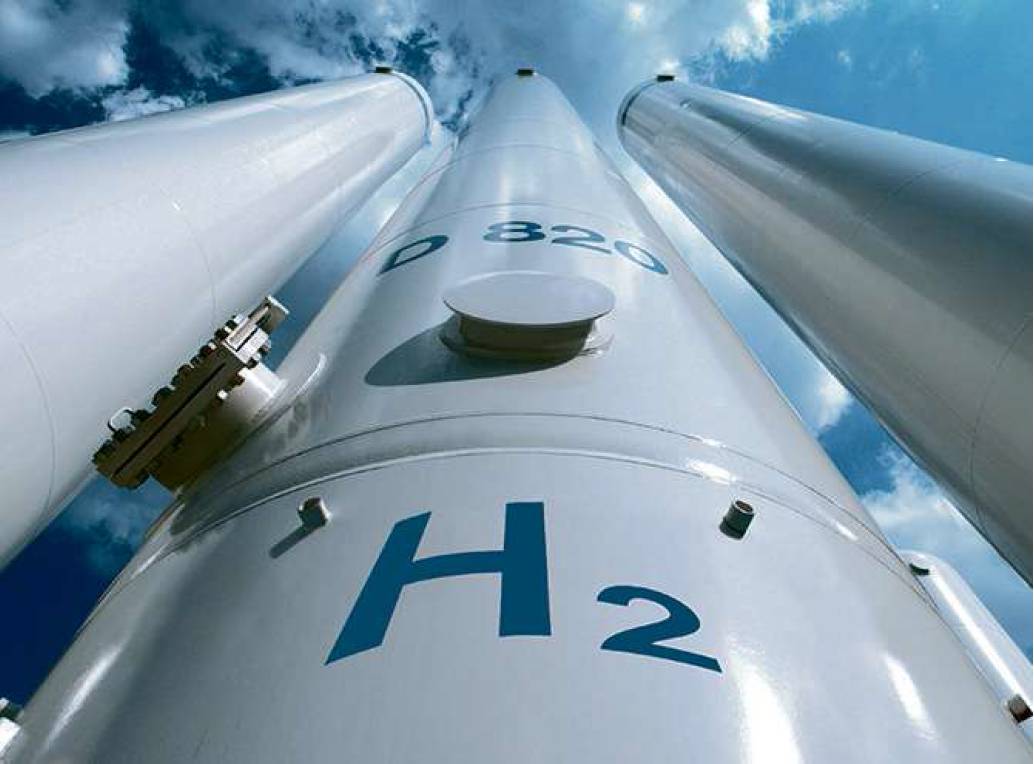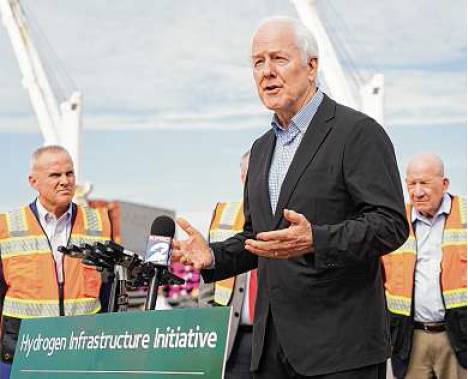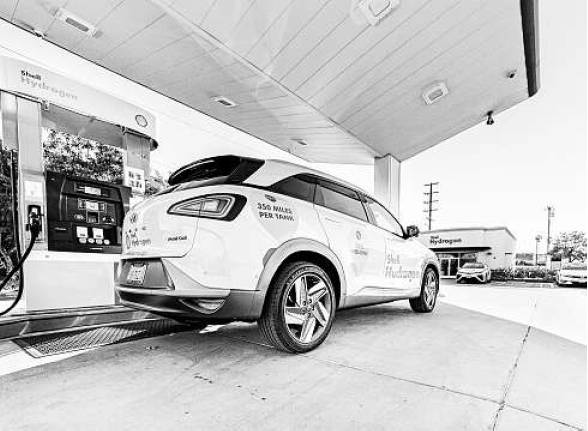GREEN ENERGY
City’s hydrogen hub faces competition
Southern California is working on similar plans for its own operation
By James Osborne STAFF WRITER
WASHINGTON — Oil companies are moving quickly to establish a global hydrogen energy industry, with Houston and its abundant supplies of cheap natural gas as the logical hub for the United States.
Convert the natural gas, which is composed of hydrogen and carbon, to zero-carbon hydrogen, and you have a fuel that can be used to power hard to electrify industries such as heavy manufacturing, trucking and shipping. The resulting carbon dioxide from the process can then be captured and pumped into abandoned oil fields in the Gulf of Mexico, where it can be stored permanently.
It all sounds pretty straightforward, except there’s a competing technology that uses water to produce the same zero-emissions hydrogen fuel, eliminating the hassle of capturing carbon and storing it underground.
The water-based technology is more expensive now — by a factor of two or three — but if projections prove right, so-called green hydrogen will soon be cheaper than making hydrogen from natural gas, posing a dilemma for oil and gas companies and their partners in Houston’s existing hydrogen industry as they seek to reduce emissions.
“They’re in a pinch,” said Alex Klaessig, a research director at IHS Markit. “They need to make a decision about plunking down $300, $400, maybe $500 million for blue hydrogen. Or they can try to buy incremental amounts of green hydrogen that are very expensive right now. And if you wait what if the cost declines don’t materialize.”
Traditionally hydrogen supplies have been made from natural gas, to feed the production of chemicals like ammonia and methanol. But with the industry looking to shift into transportation as a cleaner alternative to petroleum-based fuels, companies have been marketing so-called blue hydrogen, which is made from natural gas but with the emissions captured and stored underground, and emissions-free green hydrogen, which is made by running an electrical current through water — a technology used on NASA spacecraft.
For years now, oil executives and political leaders in Houston have studied how the city’s oil and gas infrastructure and expertise could be adapted to the clean energy transition needed to address climate change.
What they set upon, as detailed in a recent report by the University of Houston, was a combined hydrogen and carbon capture hub that would seek to clean up the region’s existing energy and petrochemical sectors while also producing new low-carbon hydrogen fuel.
To start, the UH study proposed a series of pilot projects focusing on the region’s existing hydrogen system, capturing the emissions from converting natural gas to hydrogen.
Exxon Mobil even proposed the development of a $100 billion carbon capture hub along the Houston Ship Channel, with the carbon dioxide stored offshore under the sea floor.
The question of whether to invest in gas-based hydrogen over that produced from water and powered by wind and solar farms has long posed a dilemma for the burgeoning hydrogen industry.
‘Tectonic shift’
But what seemed a far-off question has become much more immediate. A report from Bloomberg New Energy Finance last year predicted green hydrogen would be cheaper than blue hydrogen by 2030 — and in many markets, even cheaper than standard hydrogen production without carbon capture.
“This will unleash a tectonic shift in the hydrogen market,” the report read. “(Blue hydrogen) projects with expected start dates closer to 2030, such as Equinor’s H2Morrow plant in Germany, risk becoming uncompetitive against green hydrogen.”
That forecast could prove overly optimistic, but most analysts project the two technologies will converge on price at some point in the 2030s, Klaessig said.
The report is getting the attention of Democrats in Congress, many of whom have long questioned supporting a hydrogen industry that relies on fossil fuel production.
Under the bipartisan infrastructure bill passed last year, Congress appropriated $8 billion for “clean hydrogen” research and development , which includes both blue and green hydrogen technologies.
At a hearing before the Senate Energy and Natural Resources Committee last month, Sen. Martin Heinrich, D-N.M., questioned whether the federal government should support blue hydrogen production and the costly carbon capture systems it requires.
“If you do a big expensive project with (carbon capture) you need 20 to 30 years to make it back,” he said. “How do we avoid making long term investments that end up not being cost effective?”
Hydrogen companies such as the French firm Air Liquide, which has its U.S. headquarters in Houston, maintain that natural gas-based hydrogen with carbon capture is critical to expanding the industry into transportation fuel. Once green hydrogen is cost effective, there will be plenty of demand for both technologies, these companies argue.
And they have agreement from many environmentalists, who want to see heavy-duty trucks and cargo ships begin to switch off petroleum-based fuel immediately — not eight years from now.
Gaining ground
“We need a lot of clean hydrogen quickly, and we need it cost competitive,” testified Jonathan Lewis, senior counsel at the environmental group Clean Air Task Force. “Making it from any one energy source is going to make that very difficult.”
Oil companies are betting on the premise that there is room for both technologies. Exxon Mobil, for instance, signed a deal with the British natural gas firm SGN and Australia’s Macquarie Group in December to study the development of a hydrogen and carbon capture facility in southern England.
BP is exploring hydrogen projects across Europe and the Middle East, including a facility in northern England that will produce hydrogen both from water and natural gas.
“We believe both have a role to play in decarbonization. It’s not one versus the other,” Louise Jacobsen Plutt, senior vice president of hydrogen and CCUS at the oil major, said in a recent blog post. “It’s about picking the best solution for the area that can, over time, scale at the lowest possible cost.”
Green hydrogen technology, meanwhile, is gaining ground fast.
In Los Angeles, city officials, working with partners such as Mitsubishi, are looking to convert four natural gas-fired power plants to run on green hydrogen, toward driving down the price to make it affordable for heavy industry and transportation.
The hope is to eventually turn Southern California into the world’s first green hydrogen hub, a potential rival to Houston as it seeks to develop its own hydrogen industry.
“It makes sense right now to have a strategy to rapidly decarbonize existing hydrogen with carbon capture,” said Janice Lin, president of the California-based trade group Green Hydrogen Coalition. “But at the same time, we don’t want stranded assets. We do believe the future is all green.” james.osborne@chron.com


